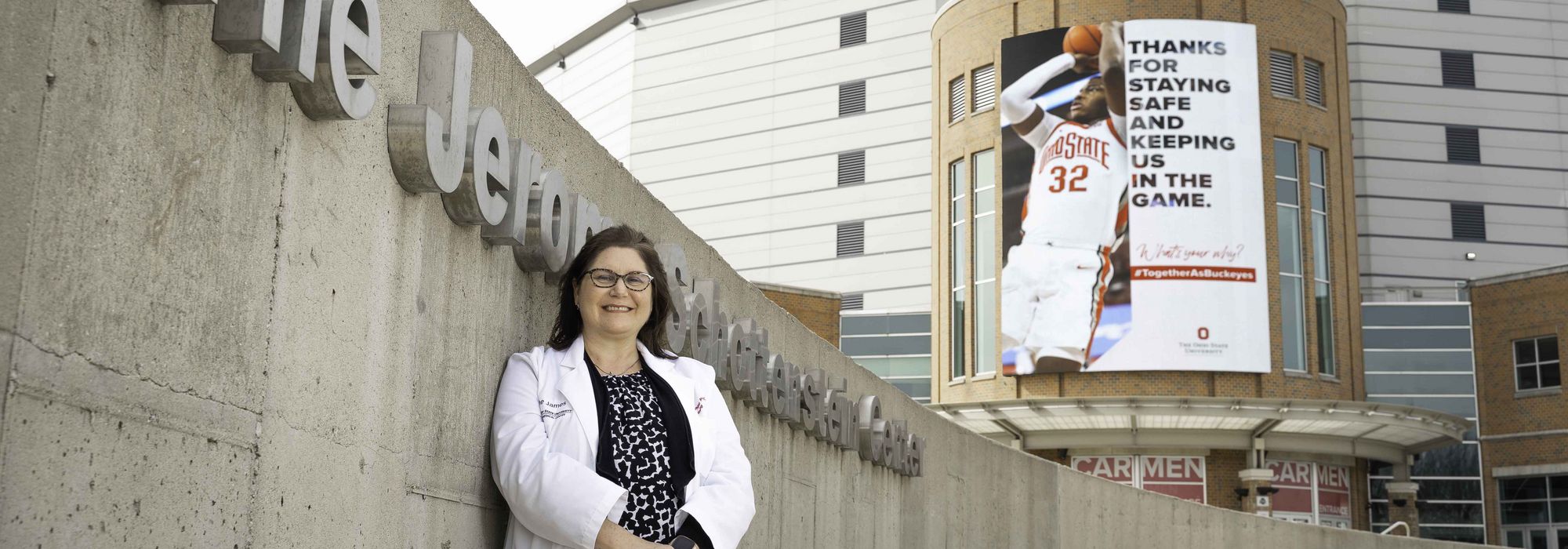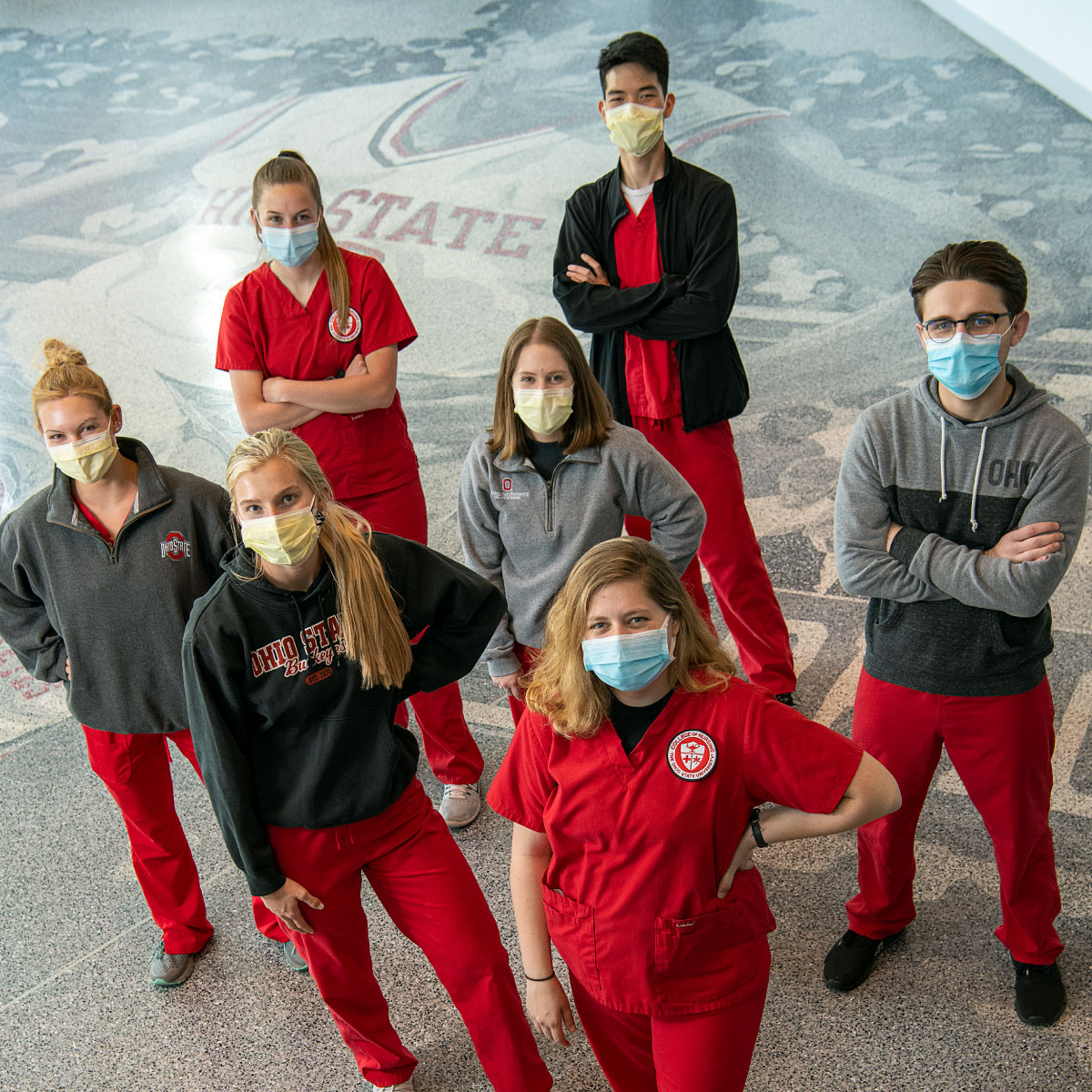
A Lot of People Power
Faculty member and alumna Kristine Browning tells us about Shots at the Schott
by Susan Neale
“When vaccines became available in December, we started talking with Wexner Medical Center about how we could best help,” said Kristine Browning, PhD, APRN-CNP, FAANP, ('97, '99 MS, '07 PhD). “We have almost 2,000 students in our building, most of them either studying to be nurses or already licensed RNs. Most of our faculty are licensed, too. That’s a lot of people power.”
It quickly became evident that The Ohio State University Wexner Medical Center (OSUWMC) would need the College of Nursing's help at Shots at the Schott, its mass vaccination initiative held at the popular sports and entertainment area, the Schottenstein Center.
Browning, who is assistant dean for graduate clinical programs, Vice Dean Margaret Graham, PhD, APRN-CNP, FAANP, FNAP, FAAN, and Assistant Dean for Baccalaureate Programs Wendy Bowles, PhD, APRN-CNP, CNE, met regularly with OSUWMC leadership to coordinate the effort.
Healthcare at the arena
Shots at the Schott needs approximately 100 people to work per 4-hour vaccination session. When we interviewed Browning in February, Shots at the Schott was running 3 sessions a day, Monday through Friday. This efficient operation vaccinates approximately 2000 patients a day, limited only by the amount of vaccine it has to distribute. The OSUWMC has come to rely on the support the College of Nursing supplies – around 14 to 24 people a day, including undergraduates, APRN students, faculty and preceptors.
Undergraduate students have been going in groups of 10, sometimes two groups per day, accompanied by faculty and preceptors. These students act as runners and help with patient education, explaining side effects and what to expect during vaccination. Those who are trained in the hospital’s electronic records system can help schedule patients for their follow-up visit. “Some of our undergrad students have really become great leaders while they’re there, and so they’re helping to train other runners who are new about the logistics and the orientation of how the whole process works,” Browning said. “Since they’re there quite often, they are great resources for the patients, too.” Students can earn clinical hours and precepted experience while they serve the public in this historic public health initiative.
Our APRN students can be vaccinators at the Schott – besides being licensed RNs already, they are experienced in working with patients and using the medical center’s computer documentation system. They can also train other vaccinators. Because of their level of skill and ability to answer questions patients have about medications and other medical concerns, our APRN students have been primarily working with immunocompromised patients in the smaller “Scarlet” area designed to protect these vulnerable patients. Up to four APRN students go to Shots at the Schott every day, along with preceptors.
Total Health and Wellness, the College of Nursing’s nurse practitioner-led clinic at The Ohio State University West Hospital, also sends teams to participate.
“It’s such a great experience, I think, as a student to feel like you’re being able to provide this much-needed service to the community and to patients, and to feel like you are educating patients, and serving in this vital role during this historic pandemic,” Browning said. “I’m so proud that the College of Nursing can participate in this experience during this public health crisis, and we’re glad that our students can take part, because soon they’re going to be out delivering care to patients.”
On the inside
Eligible patients sign up through OSUWMC’s MyChart system or call for an appointment time. Once through the doors of the Schott, it doesn’t take long to get vaccinated. “It’s very efficient,” Browning said. Patients are directed to one of the approximately 180 available seats on the “Gray” area. “Once you sit down, it takes anywhere from immediately to approximately 15 minutes to get your shot.” Patients are monitored for 15 to 30 minutes for reactions before being released. The vaccination effort takes place in the big, open outer porticos where the now-closed concession stands are. While it may look nothing like the arena on a game day, games are still taking place, sans fans, behind closed doors, and staff of the Schottenstein center who used to direct game day traffic now help with parking and ushering people inside.
At the time of our interview in February, Shots at the Schott had delivered 45,000 vaccinations so far.
“It’s such a wonderful experience for students at all levels,” Browning said. “It’s thrilling as a healthcare provider – being able to experience the process of providing these lifesaving vaccines to the public.”

